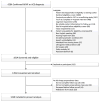Preparedness for hospital discharge and prediction of readmission
- PMID: 26929109
- PMCID: PMC5003753
- DOI: 10.1002/jhm.2572
Preparedness for hospital discharge and prediction of readmission
Abstract
Background, objective: Patients' self-reported preparedness for discharge has been shown to predict readmission. It is unclear what differences exist in the predictive abilities of 2 available discharge preparedness measures. To address this gap, we conducted a comparison of these measures.
Design, setting, patients: Adults hospitalized for cardiovascular diagnoses were enrolled in a prospective cohort.
Measurements: Two patient-reported preparedness measures assessed during postdischarge calls: the 11-item Brief Prescriptions, Ready to re-enter community, Education, Placement, Assurance of safety, Realistic expectations, Empowerment, Directed to appropriate services (B-PREPARED) and the 3-item Care Transitions Measure (CTM-3). Cox proportional hazard models analyzed the relationship between preparedness and time to first readmission or death at 30 and 90 days, adjusted for readmission risk using the administrative database-derived Length of stay, Acuity, Comorbidity, and Emergency department use (LACE) index and other covariates.
Results: Median preparedness scores were: B-PREPARED 21 (interquartile range [IQR] 18-22) and CTM-3 77.8 (IQR 66.7-100). In individual Cox models, a 4-point increase in B-PREPARED score was associated with a 16% decrease in time to readmission or death at 30 and 90 days. A 10-point increase in CTM-3 score was not associated with readmission or death at 30 days, but was associated with a 6% decrease in readmission or death at 90 days. In models with both preparedness scores, B-PREPARED retained an association with readmission or death at both 30 and 90 days. However, neither preparedness score was as strong a predictor as the LACE index when all were included in the model predicting 30- and 90-day readmission or death.
Conclusion: The B-PREPARED score was more strongly associated with readmission or death than the more widely adopted CTM-3, but neither predicted readmission as well as the LACE index. Journal of Hospital Medicine 2016;11:603-609. © 2016 Society of Hospital Medicine.
© 2016 Society of Hospital Medicine.
Conflict of interest statement
disclosures: Dr. Kripalani is a consultant to and holds equity in PictureRx, LLC. No other authors have conflicts of interest or financial disclosures.
Figures
References
-
- Centers for Medicare & Medicaid Services. [Accessed September 2, 2014];Readmissions reduction program. 2014 https://www.cms.gov/medicare/medicare-fee-for-service-payment/acuteinpat....
-
- Graumlich JF, Novotny NL, Aldag JC. Brief scale measuring patient preparedness for hospital discharge to home: Psychometric properties. Journal of Hospital Medicine. 2008;3(6):446–454. - PubMed
-
- Coleman EA, Mahoney E, Parry C. Assessing the quality of preparation for posthospital care from the patient’s perspective: the care transitions measure. Medical Care. 2005;43(3):246–255. - PubMed
-
- Parry C, Mahoney E, Chalmers SA, Coleman EA. Assessing the quality of transitional care: further applications of the care transitions measure. Med Care. 2008;46(3):317–322. - PubMed
Publication types
MeSH terms
Grants and funding
LinkOut - more resources
Full Text Sources
Other Literature Sources
Miscellaneous


